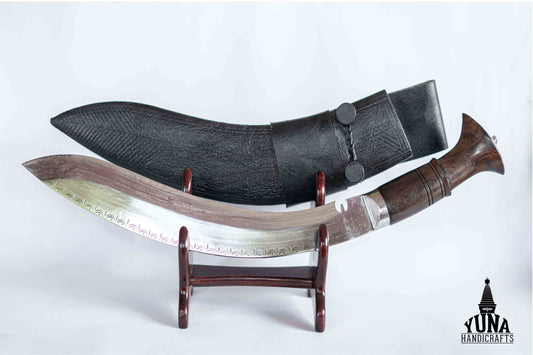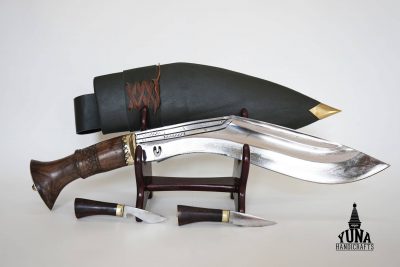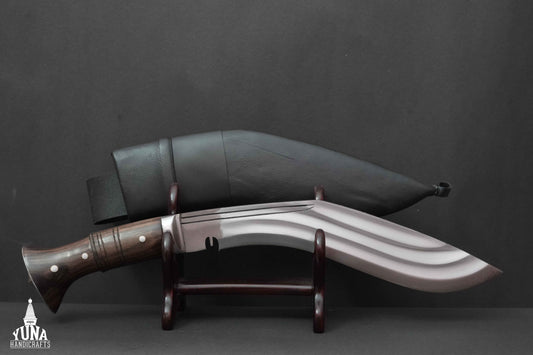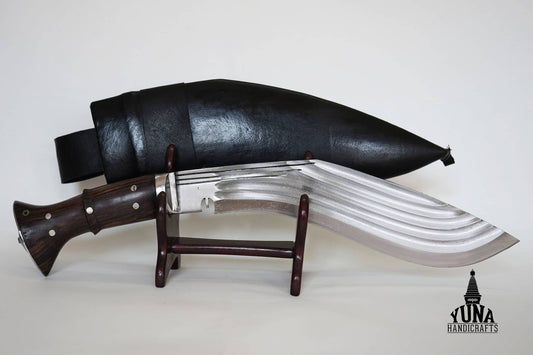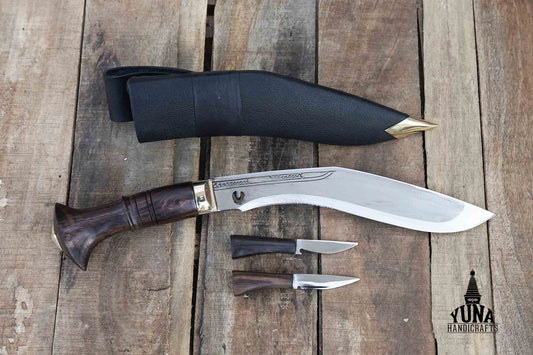
Different Parts of Gurkha Kukri Knife
The Handmade Gurkha Kukri is a national weapon of Nepal. It’s famous for its shape and size. Nepal is famous for its Gurkha warriors and Kukri. The main word for a kukri is “Khukuri”. This term is mostly used in the Asian subcontinent, and the “Kukri” word is mostly used in Britain and other countries. Kukri is designed as a sharp, single-edged, curved knife that is used for many purposes. Nepalese or Gurkha soldiers mostly use it.
All around the world, this “kukri” is well-known as “Gurkha Kukri”. Even in the Indian army and the British army, this Gurkha Kukri is used for single combat. It’s an effective weapon for a single combat fight and can be used for any cutting purpose. The main steel body is made of spring steel, and the handle is made of wood and animal horn. A Gurkha isn’t considered a Gurkha if he/she hasn’t carried a Kukuri.
It’s a handmade knife that skilled Nepalese artisans make. There are different types of Kukri you can find in the market. The shape and size are also different. The Kukri has different parts, and its parts are unique.
Different Parts of Gurkha Kukri
Tip (Tuppa)
It’s the starting point of Kukri, which starts from the top. In Nepalese terms, it’s known as “Tuppa”, which means peak. The starting point is sharply pointed.
Chest (Ang)
It’s the main body surface and with the distal portion of the Kukri. In Nepalese terms, it’s known as “Aang”.
Spine (Beet)
It’s the backbone of the Kukri. In Nepalese terms, it’s known as “Beet” or “Bitheu”. It’s in a curved shape and has the thickest blade.
Peak (Juro)
It’s the highest point of Kukri. You can see the two meeting points of the thick line on the Kukri. In Nepalese terms, it’s known as “Juro”. It’s part of the Spine (Beet) of the Kukri.
Fuller (Khol)
It’s a handmade line on the backside of the Kukri. In Nepalese terms, it’s known as “Khol”. This deep line is drawn in a staring two-line design on the spine.
Bolster (Kanzo)
This half-round-shaped metal body is placed between the body part and the handle part. It’s known as “Kanzo” in Nepalese terms. You can see it just below the Fuller (Khol).
Ring (Harhari)
It’s a handmade line designed in a circle. It’s known as “Harhari” and “Dora” in Nepalese terms. You can see the two-circle line in the handle of the Kukri.
Scale (Bhend)
It’s a portion of the handle. In Nepalese terms, it’s known as “Bhend”.
Rat Tail Tang (Paro)
It’s a hidden part of the blade passing through the handle, inside the wooden handle. It’s also known as “Paro” in Nepalese.
Butt Cap (Chapri)
It’s a metal cap for securing the handle. You can see it beneath the handle of the Kukri. In Nepalese terms, it’s called “Chapri”.
Rivet (Khil)
It’s a metallic circle that secures the grip of scales and tang. You will see a handle with three small circle knots. It’s also known as “Khil”.
Ricasso (Ghari)
It’s a small flat surface between the Notch and the Bolster. The Nepalese term for Ricasso is “Ghari”.
Notch (Kaudi)
It has a unique cut at the edge of the Kukri blade, shaped like the number 3. This cut works as a blood dropper of the enemy. In Nepalese terms, it’s called “Kaudi”.
Fuller (Chirra)
It’s the curved body part that allows for absorbing heat and reducing weight. It’s known as “Chirra” in Nepalese terms.
Edge (Dhar)
It’s the sharpest edge of the Kukri, which is used for cutting. Nepalese call this edge “Dhar”, which means sharp.

